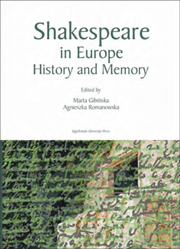Book contents
- Frontmatter
- Contents
- Preface
- Towards a European History of Henry V
- History and Histories
- The Bad Quarto Hamlet and the Polish Connection
- Cross-Histories, Straying Narratives: Anglo-Portuguese Imbrications and Shakespeare's History Plays
- The Art of War in Shakespeare and in European Renaissance Treatises
- The “Histories” of Henry VI
- Shakespeare's Imperfect Memory of History
- “Retail'd to All Posterity:” The Case of Richard III
- Halting Modernity: Richard III's Preposterous Body and History
- History and Memory: Criticism and Reception
- History, Memory, and Ideological Appropriation
- Theatre: The Act of Memory and History in the Making
- Index of Authors
The Art of War in Shakespeare and in European Renaissance Treatises
from History and Histories
Published online by Cambridge University Press: 05 September 2014
- Frontmatter
- Contents
- Preface
- Towards a European History of Henry V
- History and Histories
- The Bad Quarto Hamlet and the Polish Connection
- Cross-Histories, Straying Narratives: Anglo-Portuguese Imbrications and Shakespeare's History Plays
- The Art of War in Shakespeare and in European Renaissance Treatises
- The “Histories” of Henry VI
- Shakespeare's Imperfect Memory of History
- “Retail'd to All Posterity:” The Case of Richard III
- Halting Modernity: Richard III's Preposterous Body and History
- History and Memory: Criticism and Reception
- History, Memory, and Ideological Appropriation
- Theatre: The Act of Memory and History in the Making
- Index of Authors
Summary
1. Ideas and ideologies
Christine de Pisan lived between 1364 and c. 1430. Her family left Italy for France when she was six years old and her father became connected with the court of Charles V. Close to the French court Christine spent the rest of her life, assiduously writing poems and also social, political and religious works. In the Prologue to one of these works, she apologises for choosing a subject “unusual for women, who generally are occupied in weaving, spinning, and household duties.” The book, written in 1410, is entitled Le livre des fais d'armes et de chevalerie and is considered one of the most diligent syntheses on the art of war ever produced; not only was it widely read by subsequent compilers but is also still quoted in treatises on international law. By the end of the century Le livre des fais d'armes attracted the attention of William Caxton, who published it in his own translation in 1489. It was from Christine's book, therefore, that the English public was first acquainted with the debate on the art and the “laws” of war which by the end of the sixteenth century would develop in England with an intensity unparalleled in other European countries. But Le livre des fais d'armes was also intrinsically an important achievement because it merged the different traditions making up the picture of war ideology by the end of the Middle Ages.
- Type
- Chapter
- Information
- Shakespeare in EuropeHistory and Memory, pp. 57 - 78Publisher: Jagiellonian University PressPrint publication year: 2008

